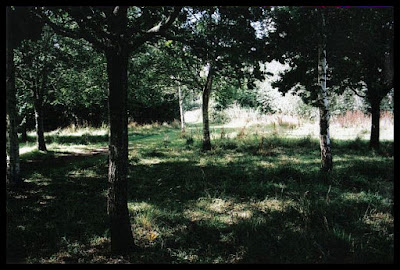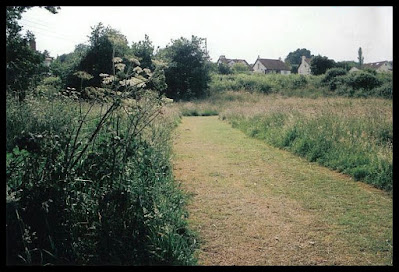I came across this unexpectedly when walking along the nearby lane in the late summer of 2013. I hadn't been along this way for a good 20 yrs or more and didn't realise that this field has a name and is now a nature recreational area, so I went in for a look and took a few photos. I liked it so much that I went again a week later with a picnic lunch and took more photos.
I'd been trying to find out the circumstances which led to the saving of Tracey's Field and subsequent use as a public space. I vaguely remembered a newspaper article of around 1995, which said that the field was saved from the threat of development; a new housing estate had been built and the field was the only open space left in that area. Then a friend told me that Tracey was the name of the lady that owned it; having bequeathed that it should be left as a wildlife haven for the people of Seaton to enjoy, and stipulating that it can never be built upon.
The
field is divided into sections by the use of hedges. One of these
contains a small copse of ash trees, near to the entrance where I went in, and a green tunnel making a wonderfully liminal place between the copse and the next part of the field.
Looking back towards the tunnel, above, and forward towards the top of this field, below.
These other sections are given over to hedge-bordered meadows with paths created by mowing between areas of meadow grass and wild flowers. Seating is provided here and there, ranging from wooden garden seats, as seen in the first few photos, to simple rustic benches, below.
Because it's on the outskirts of town, and isn't a particularly built-up area to the north anyway, seeing the odd few houses doesn't diminish the peacefulness of Tracey's Field. And even though there is a main road going into Seaton by the top end of the field any noise from traffic is mitigated by the trees and hedges.
My photos really don't do it justice. I scanned these when I still used a CRT monitor so I rather 'overcooked' some of them during editing. Also, I think it's one of those places that don't look like much until you're actually there to feel the lovely atmosphere of it. It's a little bit magic and now that I've reminded myself of its existence I don't have any excuse not to visit again.
Above and below, one of several entrances between the hedges, making several different areas within the field.
And some of the hedges full of wild flowers. My friend from Worcestershire once stayed with us on holiday when both our children were little. She'd brought a book of wild flowers with her and was most disappointed that there didn't seem to be many in Devon during the latter part of Summer. This is because our seasons come earlier here on the peninsular and the best time to see them flowering is in Spring and early Summer. Again, this was late and so there wasn't quite as much to see, apart from the foliage and a few blooms.
The purple flowers seen here are of the Great Hairy Willowherb. There are some yellow flowers beyond them (below) but I can't tell from the photo what they are, although I think they might be Ragwort as they are the right height and size for them. Amongst the foliage are Nettles, Docks, Hogweed, Dog Roses and the winding tendrils of Major Convolvulous (also known as Bindweed).
And lastly, is the delightfully bosky Homer Lane. Now closed to vehicles, it's incredible to think that this was once a busy road. Mind, this being Devon, there are loads of tiny twisty lanes between high hedgerows known as Devon Banks, where drivers often have to back towards a suitable width to allow oncoming traffic through. With its central white line still in place, this pretty lane has been allowed to grow over even more now that it's pedestrian only.
The part of Homer Lane which runs parallel to the field is bisected by a road called Tracey's Way, which is a lovely way to honour the bequest from a very thoughtful and generous lady.

























No comments:
Post a Comment